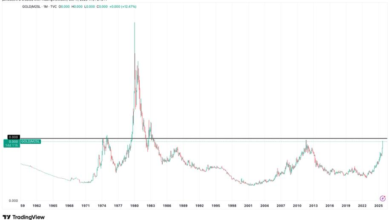Three reasons to be deeply skeptical about the current gold rally

Gold has been soaring in value, which many see as investors’ way of protecting themselves in a volatile market.Jae C. Hong/The Associated Press
Let me confess something: I have always had a tough time with the concept of gold as an investment. Bullion pays no interest, dispenses no dividends, generates no cash flows. It simply sits there. At first glance, this does not sound like something you should rush to own.
The case for gold doesn’t grow any stronger the more you ponder the matter. The economist John Maynard Keynes famously dismissed the metal’s role in the monetary system as “a barbarous relic.” Warren Buffett, who knows a thing or two about markets, is just as unimpressed. He has mocked the enormous effort that people expend on digging the stuff out of the ground, only to bury it right back underground in a central bank vault.
Strangely, though, all these sage opinions have done absolutely nothing to deter the price of gold from shooting upward over the past three years. The action over the past few months has been particularly frantic. Since January, the near vertical takeoff in bullion’s value looks like a rocket launch.
The bullish case for gold paid off. Now what?
So perhaps it’s time for a skeptic’s guide to gold investing. Let me offer up three thoughts that you can chuckle about as you count your bullion profits.
My first thought is that this gold mania isn’t like past gold manias. The previous episodes, around 1980 and 2011, at least had an element of predictability to them.
In both cases, precious metal prices shot upward as the real yields on bonds tanked. (“Real yield” simply means the yield after adjusting for inflation. If a bond is paying you 5 per cent a year and inflation is running at 2 per cent, the real yield is 3 per cent.)
An inverse relationship between real bond yields and the price of gold makes perfect sense. After all, if bonds are offering you a generous payout, why would anyone want to gamble on owning gold, which pays you nothing? Generally speaking, it’s only when the real payoffs from owning bonds tumble to unattractive lows that bullion begins to look appealing.
Except for right now, that is. Real bond yields have climbed higher over the past three years – a trend that should spell trouble for bullion in any rational universe. Yet, for some reason, gold has defied the usual logic and soared in value.
This doesn’t make obvious sense. So what’s going on? Many commentators have seized on the idea that investors must be rushing to gold as a way to protect themselves from potential U.S. dollar debasement.
The standard story is that people are worried about Washington’s vast budget deficits and refusal to deal with fiscal reality. Supposedly, fears are growing that U.S. President Donald Trump will seize effective control of the Federal Reserve and use his power to chop interest rates, thereby stoking inflationary fires.
This narrative is absolutely plausible in the long run. The problem, though, is that it is not reflected anywhere else in financial markets right now.
If U.S. dollar debasement were an imminent threat, investors should be rushing to dump the greenback. U.S. bond yields should be soaring as investors seek extra compensation for the carnage that is to come.
By and large, neither of these things is happening. Granted, the U.S. dollar has lost about 13 per cent of its value against a basket of other major currencies since 2022. But it’s hard to see how that justifies the 250-per-cent run-up in gold during the same period.
The greenback is now trading roughly in line with its value from 2015 to 2020, when few people talked about dollar debasement. U.S. bond yields are not doing much of anything. Meanwhile, people are still rushing to buy U.S. stocks, which are denominated in U.S. dollars.
All of this adds up to quite a puzzle for anyone who wants to understand the bullion market. It brings me to a second observation: Nobody really knows what is driving the gold frenzy.
It is distinctly odd, as Morgan Stanley Wealth Management noted this week, to see U.S. stocks roar upward at the same time as gold is also ripping higher.
Trump’s policies have hurt safe-haven status of U.S. dollar, Macklem says
The two trends represent diametrically opposed outlooks. The bull market on Wall Street suggests widespread euphoria about what lies ahead. The bull market in gold suggests a desperate search for safety.
Make of this what you will. “The latest rise in gold prices seems to have also come out of nowhere and no one really has any idea what’s going on,” economist Robin Brooks, senior fellow at the Brookings Institution, wrote this week in what may be the most honest assessment of the current situation.
So this brings me to a third and final thought: It is not generally a good idea to invest in an asset that is rising for reasons you don’t understand.
I can understand the desire to ride the gold bandwagon. Just be aware that the perception of safety in gold is largely an illusion. Someone who bought bullion at its 1980 peak would have had to wait 25 years to get back to even. Someone who bought gold at its 2011 peak would have had to wait nine years to be back to where they started.
So conduct yourself accordingly. It would not be a huge surprise to see the gold price rocket from its current level around US$4,225 to hit US$5,000 or more over the next couple of years. It would also not be a surprise to see it plunge to US$3,000 or lower. Jump on the gold bandwagon if you will. Just be prepared to jump off at the first sign of trouble.





